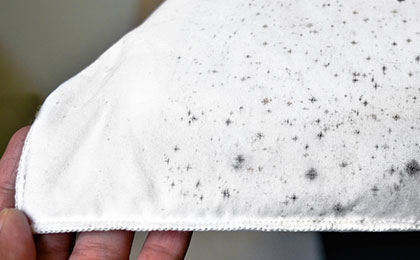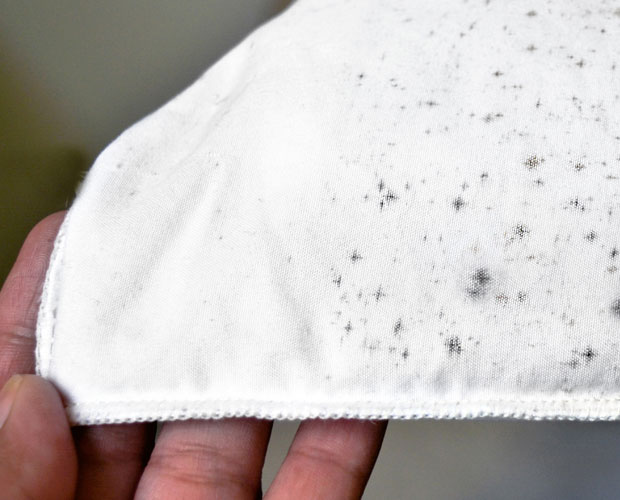
Mold on Clothes: Causes, Risks, and How to Remove It Effectively
You open your closet, and there it is - that unmistakable musty smell. Instinctively, you start searching for the source, only to discover mold on your clothes. It's frustrating, but now that you've identified the problem, the real question is: what do you do about it?
In this article, we'll dive into the common causes of mold on clothes, how it can pose risks to your belongings and health, and most importantly, what steps you can take to remove it. Whether it's a favorite coat, a beloved jacket or shoes we've got you covered with practical tips to tackle mold and prevent it from making a comeback. Let's get started!
5 Causes Why Mold Grows on Clothes
Mold on clothes doesn't happen randomly - it thrives under specific conditions that turn your belongings into its ideal home. To understand why mold targets clothes and closets, let's explore five key factors contributing to its growth.
1. Damp Conditions
Moisture is the most common reason for mold growth. Damp clothes stored without proper drying create the perfect environment for mold spores to flourish. For example, placing a rain-soaked coat into the closet can lead to the development of mold, which can spread to other clothes.
2. Sweat and Dirt Build-Up
Sweat and dirt provide nutrients that accelerate mold growth. Mold on clothes often develops on items worn and stored unwashed, especially on areas where garments come into contact with your skin, leaving behind oils and residues.
3. Mold in the Closet
Existing mold issues in the place where you store your clothes is another major contributor. Clothes are highly susceptible to mold in closets where airborne spores can spread through the air and settle on your belongings. Even seemingly dry items can become new targets for mold, turning your wardrobe into a battleground for microbial growth.
4. Poor Ventilation in Storage Areas
Closets and compartments with poor ventilation create a stagnant environment, allowing moisture to build up over time. Without adequate airflow, airborne mold spores have plenty of opportunity to settle and grow on clothes. Poor ventilation is particularly problematic in enclosed or tightly packed storage spaces, where moisture becomes trapped.
5. High Humidity Levels
High humidity is a critical factor for mold growth. When the surrounding air is saturated with moisture, it can encourage mold development even on dry clothes. Seasonal humidity fluctuations or naturally humid climates further exacerbate the problem, especially in poorly ventilated storage spaces.
By understanding these five causes - damp conditions, sweat and dirt build-up, mold in the closet, poor ventilation, and high humidity levels - you can better identify the root of the problem. These factors highlight why mold often finds a home on clothes, making them an unwelcome host for mold spores.
How to Get Mold Out of Clothes
Dealing with mold on clothes requires a thorough approach to ensure the removal of visible mold, leftover mold spores, and the persistent musty smell. Mycotoxins, the harmful microscopic particles produced by mold, can remain on clothes even after initial cleaning. While heavily contaminated garments might need to be discarded, most clothes can be saved by following these steps:
1. Identify the Signs of Mold and Air Out the Clothes
Start by inspecting your garments for signs of mold, such as dark patches, discoloration, or the unmistakable musty smell. Once you've identified mold on clothes, take the items outside to air them out. This keeps spores from spreading indoors and allows fresh air and sunlight to begin breaking down surface mold.
2. Brush Off Visible Mold
Using a soft-bristle brush, gently remove any visible mold on clothes. Mold spores can easily transfer during this step, so wear gloves, goggles, and a mask to protect yourself. Dispose of the brush or clean it thoroughly to avoid further contamination.
3. Soak Clothes to Kill Mold Spores
Prepare a soaking solution to target leftover mold spores. Fill a large container or bathtub with water and add 1 cup of vinegar per gallon of water, or use a fabric-safe mold remover. Let the moldy clothes soak for at least an hour to ensure that the mold is killed both on the surface and deep within the fabric.
4. Wash Separately in Hot Water
Place the clothes in the washing machine but keep them separate from other laundry to prevent cross-contamination. Use hot water and a high-quality detergent specifically designed for tough stains. The heat and detergent will work together to remove mold on clothes and eliminate any remaining spores or musty smells.
5. Dry Outside in Sunlight
After washing, hang the clothes outdoors in direct sunlight. The UV rays help kill any lingering mold spores, while fresh air works to eliminate the musty smell. Ensure the clothes are thoroughly dry before bringing them back inside to prevent re-contamination.
6. Repeat If Necessary
If signs of mold or musty odors persist, repeat the soaking, washing, and drying process. For stubborn cases, consider professional laundry services. Always keep moldy clothes separate from other garments to avoid spreading the issue further.
Preventive Measures to Avoid Mold on Clothes
Preventing mold on clothes requires proper care and attention to both the garments themselves and their storage environment. By eliminating conditions that encourage mold growth, you can ensure your clothes stay fresh and mold-free. Here are some practical steps to follow:
- Dry Clothes Thoroughly Before Storing
- Wash Clothes Before Storage
- Improve Ventilation in Your Closet
- Keep Humidity Levels in Check
- Choose Mold-Resistant Storage Materials
- Inspect and Refresh Periodically
- Tackle Moisture Issues Immediately
Let's stop closely at your storage compartment, especially your closet, which can easily become a breeding ground for mold. Mold in closets is often the most immediate cause of mold on clothes. Hidden in dark corners, it can quietly develop into a significant problem - not just for the belongings stored inside but for the entire house. This is why checking ventilation and humidity in your closet is crucial, as these are the primary factors that encourage mold growth and its spread onto clothes.
The first signs of mold in a closet are often hard to detect. By the time you notice the musty smell or faint discoloration, mold spores may already have spread from your closet to your clothes and potentially to other areas of your home, leading to widespread contamination.
Periodic cleaning of your closet serves multiple purposes. Not only does it provide ventilation during the cleaning process, but it also gives you a chance to inspect for mold on walls or any early warning signs. If you come across significant mold patches during such cleanings, it's essential to stop immediately and conduct a proper mold inspection.
Why is this so important? A mold patch on the wall might not just be surface mildew - it could signal the presence of serious black toxic mold caused by water damage or hidden leaks. In such cases, attempting to clean it yourself might worsen the problem. Professional mold removal service is the best course of action, as it will not only save your closet and belongings but also protect your home from further damage and potential health risks.
Conclusion
Now you know what to do if you notice mold on your clothes. The main goal of this article is to guide you through the most reasonable steps to handle the situation effectively. While we've outlined practical methods to clean your clothes, we've also highlighted the bigger picture - mold is a serious problem that goes beyond just your wardrobe.
Once you find mold, it's crucial to check everything in your closet and even the surrounding areas to ensure mold hasn't spread further. Mold contamination can quickly escalate, affecting your entire home. If you notice clear signs of mold, like patches on walls or a persistent musty smell, it's better to consult a professional. The issue may be deeper than it appears, and leaving it unchecked could lead to far greater costs and risks down the line.
That's why we at Mold Act are here - not just to provide DIY tips but also to step in when professional remediation is needed. We ensure thorough mold removal and prevention, safeguarding both your belongings and your home. Trust Mold Act to handle what's beyond your reach, because when it comes to mold, expert care makes all the difference.



Mold Remediation Services

